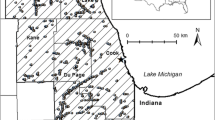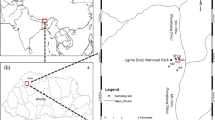Abstract
A vast ecosystem of wetlands and lakes once covered the Mesopotamian Plain of southern Iraq. Widespread drainage in the 1990s nearly obliterated both components of the landscape. This paper reports the results of a study undertaken in 1972–1975 on the vegetation of the wetlands prior to drainage and provides a unique baseline for gauging future restoration of the wetland ecosystems in Mesopotamia. Five representative study sites were used to assess the flora, three of which were wetlands. A total of 371 plant species were recorded in the five sites, of which approximately 40% represent obligate or facultative wetland species. The wetland vegetation was classified into five major physiognomic forms (submerged, floating, herbaceous tall emergent, herbaceous low emergent and woody low emergent), which was further subdivided into 24 fresh and halophytic communities. Water levels greatly fluctuated across the different types of wetlands, and mean surface water depth ranged from below to greater than 2 m above the sediment surface, reflecting permanently, seasonally or intermittently wet habitats. Aboveground biomass was also highly variable among the communities. The Phragmites australis community, which was the most extensive community type, had the greatest biomass with an average value of approximately 5,000 g m−2 in summer. Distribution and community composition were largely controlled by water levels and saline-freshwater gradients. Canonical correspondence analysis showed that salinity and water depth were the most important factors to explain species distribution. Environmental variables related to soil salinity separated halophytic species in woody low emergent and herbaceous low emergent forms (Tamarix galica, Cressa cretica, Alhagi mannifera, Aeluropus lagopoides, Juncus rigida, and Suaeda vermiculata) from other species. Their habitats were also the driest, and soil organic matter content was lower than those of other species. Habitats with deepest water were dominated by submerged aquatic and floating leaved species such as Nymphoides peltata, Ceratophyllum demersum, and Najas armata. Such diverse environmental conditions in the Mesopotamian wetland would be greatly affected by evapotranspiration, river water inputs from north, ground water inputs, local soil conditions, and a tide or seiche-controlled northward transgression of water from the Gulf. These environmental conditions should be considered in restoration plans if plant communities existed in the mid-1970s are to be part of the desired restoration goals.






Similar content being viewed by others
References
Akhani H (2004) Halophytic vegetation of Iran: towards a syntaxonomical classification. Annali di Botanica, Nuova Series 4:65–82
Al-Hilli MR (1977) Studies on the plant ecology of the Ahwar region in southern Iraq. PhD thesis, University of Cairo, Cairo, Egypt
Al-Hilli MR (1987) Remote sensing and the ecology of vegetational changes in the Fohood area, Iraq. J Agric Water Resour Res 6:17–38
Banat KM, Howari FM, Abdullah MB (2006) Mineralogy and hydrochemical characteristics of the late marshes and swamps of Hor Al Hammar, southern Iraq. J Arid Environ 65:400–419
Bouyoucos GJ (1962) Hydrometer method improved for making particle size analysis of soils. Agron J 54:464–465
Brasington J (2002) Monitoring marshland degradation using multispectral remote sensed imagery. In: Nicholson E, Clark P (eds) The Iraqi marshlands: a human and environmental study. Politicos Publishing, London, pp 151–168
Braun-Blanquet J (1964) Pflanzensoziologie; Grundzuge Der Vegetationskunde. Springer, Wien
Buringh P (1960) Soils and soil conditions in Iraq. Ministry of Agriculture, Republic of Iraq
Chapman HD, Pratt PF (1961) Methods of analysis for soils, plants and waters. University of California, Division of Agriculture Sciences, Citrus Experiment Station
Evans M (2002) The ecosystem. In: Nicholson E, Clark P (eds) The Iraqi marshlands: a human and environmental study. Politicos Publishing, London, pp 201–222
Golterman HL (1971) Methods for chemical analysis of fresh waters. International biological programme by Blackwell Scientific. IBP Handbook No. 8. Oxford and Edinburgh
Grontved J (1957) A sampler for underwater macrovegetation in shallow waters. Journal du Conseil International pour I’Exploration de la Mer 22:293–297
Guest E, Al-Rawi A (1966) The flora of Iraq: introduction to the flora, vol. 1. Ministry of Agriculture, Baghdad
Hansman JF (1978) The Mesopotamian Delta in the first millennium B.C. Geogr J 144:49–61
Jackson ML (1960) Soil chemical analysis. Prentice Hall, Englewood Cliffs
Jafari M, Zare Chahouki MA, Tavili A, Azarnivand H (2003) Soil-vegetation relationships in Hoz-e-Soltan region of Qom province, Iran. Pak J Nutr 2:329–334
Kaplan D, Oron T, Gutman M (1998) Development of macrophyte vegetation in the Agmon wetland of Israel by spontaneous colonization and reintroduction. Wetlands Ecol Manage 6:143–150
Khedr AHA, El-Demerdash MA (1997) Distribution of aquatic plants in relation to environmental factors in the Nile Delta. Aquat Bot 56:75–86
Lambeck K (1996) Shoreline reconstructions for the Persian Gulf since the last glacial maximum. Earth Planet Sci Lett 142:43–57
Maltby E (1994) An environmental and ecological study of the Marshlands of Mesopotamia. Wetland Ecosystem Research Group, Exeter University. Amar Appeal Trust, London
Middleton B (1999) Wetland restoration: flood pulsing and disturbance dynamics. Wiley, New York
Mitchell C (2002) Assault on the marshlands. In: Nicholson E, Clark P (eds) The Iraqi marshlands: a human and environmental study. Politicos Publishing, London, pp 64–100
Mitsch WJ, Gosselink JG (2000) Wetlands, 3rd edn. Wiley, New York
Naff T, Hanna G (2002) The marshes of southern Iraq: a hydro-engineering and political profile. In: Nicholson E, Clark P (eds) The Iraqi marshlands: a human and environmental study. Politicos Publishing, London, pp 169–200
Nygaard G (1958) On the productivity of the bottom vegetation in the lake Grane Langsø. Internationale Vereinigung für theoretische und angewandte Limnologie, Verhandlungen 13:144–155
Ochsenschlager EL (2004) Iraq’s marsh Arabs in the Garden of Eden. University of Pennsylvania Museum of Archaeology and Anthrology, Philadelphia
Partow H (2001) The Mesopotamian Marshlands: demise of an ecosystem. Division of Early Warning and Assessment, UNEP, Nairobi
Pearce F (1993) Draining life from Iraq’s marshes: Saddam Hussein is using an old idea to force Marsh Arabs from their home. New Sci 1869:11–12
Pearsall WH, Gorham E (1956) Production ecology I. Standing crops of natural vegetation. Oikos 7:193–201
Rechinger KH (1964) Flora of lowland Iraq. Verlag von J. Cramer, Weinheim
Richardson CJ, Hussain NA (2006) Restoring the Garden of Eden: an ecological assessment of the marshes of Iraq. Bioscience 56:477–489
Richardson CJ, Reiss P, Hussein NA, Alwash AJ, Pool DJ (2005) The restoration potential of the Mesopotamian marshes of Iraq. Science 307:1307–1311
Rickett HW (1922) A quantitative study of the larger aquatic plants of Lake Mendota. T Wisc Acad Sci 20:501–527
Rzóska J (1980) Euphrates and Tigris, Mesopotamian ecology and destiny. W. Junk, The Hague, 122 pp
Sanlaville P (2002) The deltaic complex of the Lower Mesopotamian Plain and its evolution through millennia. In: Nicholson E, Clark P (eds) The Iraqi marshlands: a human and environmental study. Politicos Publishing, London, pp 133–150
Sarbu A (2006) Aquatic macrophytes. In: Tudorancea C, Tudorancea MM (eds) Danube Delta: genesis and biodiversity. Backhuys Publishers, Leiden, pp 133–175
Scott DA (1995) A directory of wetlands in the Middle East. IUCN, Gland, Switzerland; IWRB, Slimbridge
Shaltout KH, El-Sheikh MA (1993) Vegetation-environment relationships along water courses in the Nile Delta region. J Veg Sci 4:567–570
Shaltout KH, El-Kady HF, Al-Sodany YM (1995) Vegetation analysis of the Mediterranean region of Nile Delta. Vegetatio 116:73–83
Standley PC (1940) Plants collected by the Field Museum Expedition, 1934. In: Field H (ed) The anthropology of Iraq, Part l, The Upper Euphrates, Field Museum of Natural History, Anthropology Series 30:165–197
ter Braak CJF, Smilauer P (2002) CANOCO reference manual and CanoDraw for Windows user’s guide. Software for canonical community ordination (version 4.5). Microcomputer Power, Ithaca
Thesinger W (1985) The Marsh Arabs. Harper Collins Publishers, London
UNEP (2005) Vegetation of Mesopotamian marshes. Report to CIMI, November 2005. UNEP, Geneva
U.S. Salinity Laboratory Staff (1954) Diagnosis and improvement of saline and alkali soils. Handbook No. 60. U.S.D.A., Washington
Wilson LR (1935) Lake development and plant succession in Vilas county, Wisconsin. Part 1. The medium hard water lakes. Ecol Monogr 5:207–247
World Climate (2005) World climate. Buttle and Tuttle Ltd. http://www.worldclimate.com, cited 21 May 2007
WWF (2001) Terrestrial biorealms: freshwater ecosystems. World Wildlife Fund, Gland, Switzerland. http://www.panda.org/about_wwf/where_we_work/ecoregions/mesopotamian_delta_marshes.cfm, cited 21 May 2007
Zahran MA, El-Demerdash MA, Mashaly IA (1990) Vegetation types of the deltaic Mediterranean coast of Egypt and their environment. J Veg Sci 1:305–310
Zohary M (1973) Geobotanical foundations of the Middle East, vol 1–2. J. Cramer Verlag, Berlin
Acknowledgements
The paper was prepared with the financial support of the Canada-Iraq Marshlands Initiative and the Canadian International Development Agency.
Author information
Authors and Affiliations
Corresponding author
Electronic supplementary material
Below is the link to the electronic supplementary material.
Rights and permissions
About this article
Cite this article
Al-Hilli, M.R.A., Warner, B.G., Asada, T. et al. An assessment of vegetation and environmental controls in the 1970s of the Mesopotamian wetlands of southern Iraq. Wetlands Ecol Manage 17, 207–223 (2009). https://doi.org/10.1007/s11273-008-9099-1
Received:
Accepted:
Published:
Issue Date:
DOI: https://doi.org/10.1007/s11273-008-9099-1




